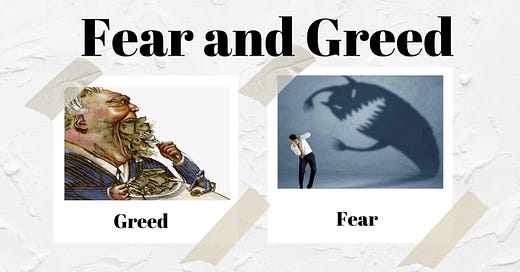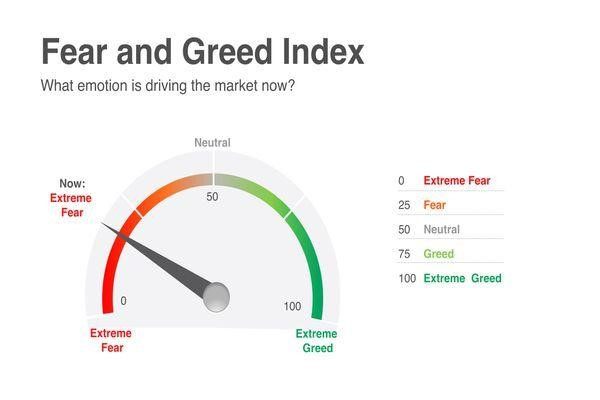“(…) to be fearful when others are greedy and to be greedy only when others are fearful”.
Warren Buffet
Part 1
The control of our emotions
“Our goal is more modest: we simply attempt to be fearful when others are greedy and to be greedy only when others are fearful.” Warren Buffet
These words originally found in the 1986 Annual letter to the shareholders of Berkshire Hathaway are considered an investor’s mantra. The quote is frequently used, but not always knowing the full context in which it was said. I thought then that it was worth reading a few paragraphs of the letter to reflect and extrapolate some lessons to our daily life.
(...) We must, of necessity, hold marketable securities in our
insurance companies and, as money comes in, we have only five
directions to go: (1) long-term common stock investments; (2)
long-term fixed-income securities; (3) medium-term fixed-income
securities; (4) short-term cash equivalents; and (5) short-term
arbitrage commitments.
Common stocks, of course, are the most fun. When conditions
are right that is, when companies with good economics and good
management sell well below intrinsic business value - stocks
sometimes provide grand-slam home runs. But we currently find no
equities that come close to meeting our tests. This statement in
no way translates into a stock market prediction: we have no idea
- and never have had - whether the market is going to go up,
down, or sideways in the near- or intermediate term future.
What we do know, however, is that occasional outbreaks of
those two super-contagious diseases, fear and greed, will forever
occur in the investment community. The timing of these epidemics
will be unpredictable. And the market aberrations produced by
them will be equally unpredictable, both as to duration and
degree. Therefore, we never try to anticipate the arrival or
departure of either disease. Our goal is more modest: we simply
attempt to be fearful when others are greedy and to be greedy
only when others are fearful.
As this is written, little fear is visible in Wall Street.
Instead, euphoria prevails - and why not? What could be more
exhilarating than to participate in a bull market in which the
rewards to owners of businesses become gloriously uncoupled from
the plodding performances of the businesses themselves.
Unfortunately, however, stocks can’t outperform businesses
indefinitely.
Insights from paragraph 1.
No matter how many decisions you think you have to make in life, there are probably no more than 5 big choices that will determine the course of your life (arbitrarily using the number 5 to mirror the investment options outlined in the letter, but the idea is clear: a lot fewer than you think).
The secret is to thoroughly evaluate their benefit-risk profile, and act accordingly. The same decision will not carry the same consequences if the risk outpaces the benefits compared to the benefits outweighing the risks. You may still make it, but you must prepare to navigate them differently.
Managing risk is one of the most important skills to master in life. Many decisions are made without a clear idea of how their consequences may play out three, five or ten moves ahead; without a proper understanding of the opportunity cost. We can’t control every variable of course, and the unknowns are many, but the lessons should be clear: not every moment in life is the right one to buy volatile growth tech stocks, we may not be ready to ride the rollercoaster. There are moments where a stable treasury bond will do just fine.
In the end you must do whatever you think is best for you in every moment, the outcome is never guaranteed and failure will occur no matter what. But the mistake you cannot afford to make is to buy one thinking you have just bought the other. Understand what you hold, own your decisions.
Insights from paragraph 2.
Speaking of risk, undoubtedly the most risky options in life are often the most fun, however to make a risky decision (not an uncontrolled gamble) you must understand two things well:
A risky bet will only pay off if we understand well its fundamentals and have trust in the people that will impact its outcome
No matter how much due diligence you do, things will likely be unpredictable in the short-medium term, and black swans that can change the game completely can happen at any moment. However, nothing beats being prepared for the long ride. In the long run discipline pays off.
Insights from paragraph 3.
At some points in life, triggered by external events or by personal circumstances, we will suffer from “outbreaks of greed or fear”.
Greed translates into the risk of being over confident in our own abilities or in thinking that the winds will always blows our way. Fear translates into the risk of being our worst enemy, self-sabotaging every possibility of success or missing on favorable circumstances.
In fear we tend to get all out; in greed we tend to go all in. Both lead to big losses.
The sentiments of fear and greed will test our character. A fine balance between self-awareness to slow down when moving too fast, and courage to act when feeling paralyzed; will be required to master to navigate rough waters.
Insights from paragraph 4.
This single phrase in the letter is gold. “Stocks can’t outperform their business indefinitely”. There are bull moments in life when everything seems to go our way no matter what, but there is a very important lesson here:
- We can never let positive momentum outrun the fundamentals of our competencies.
Note: The ‘Fear and Greed Index’ uses a scale of 0 to 100. The higher the reading, the greedier the investor’s sentiment, with a score of 50 signaling that sentiment is neutral.
Part 2
Human behavior and decision making
There is nothing more fascinating than to study the human behavior. We think of ourselves as highly rationale beings but more often than not we are indeed at the mercy of our emotions.
Let’s imagine a career journey, and think how these emotions play out influencing our decision making process.
1 - the emotional components
You start a new role with optimism, everything around you is encouraging, you feel enthusiastic. This is positive, but it is precisely here when you need to focus on consolidating, on being consistent, on aligning with the stakeholders that will be important to help you succeed in this journey.
I have seen many overly confident or blindly optimistic, letting “greed” dominate their actions and finding themselves riding an emotional roller-coaster later one, one that takes them from genuine enthusiasm to unsubstantiated exuberance and euphoria.
For example clear mistakes are not paying attention to early feedback, not reading the signals. The train takes you then to the next natural stops, from anxiety all the way to denial: ‘Everything is fine’ you think. But it is not!
The next phase becomes obvious when you realize that things are not going the way they were supposed to go, and you start doubting yourself instead of simply pausing. Your mind gets hijacked by fear and despair, and now you are in panic.
Of course these may not be literally a formal sequence of events and sentiments, but it serves as a good representation of what happens when you get ahead of yourself and momentum stops.
The problem compounds when you enter the second emotional roller-coaster, the one that goes all the way down from capitulation and discouragement to raising back up to dismay and hope.
If the first roller-coaster would have been the time to stop and seek advice; the second one should have been the best moment to simply keep focused on the job at hand, not to get distracted, doubling down on what is clear will make the difference, the rest is all noise.
But you are on the other side now, unfortunately unchanged; the fear stopped, things moved along: “it was not the end of the world”. You feel relieved and start exuding optimism again… and you just start all over again.
Without self-awareness you are condemned to repeat the same patterns of behavior.
Now, this may all seem too extreme, and it is in some way. But in my experience, I have seen too many people feeling stuck in their career unaware of any of this.
Are you on the driving seat in your own car, with a good co-pilot by your side; or are you simply riding rollercoasters?
2 - The rational components
In order to go a bit deeper in the understanding of how this Index is built, here are the seven indicators that are used to calculate score; they have tremendous implications in the case I am trying to make: that good data that for rational decision-making is at high risk of being controlled by extreme emotions.
We don’t need to get technical, but I believe that each component is a perfect representation of the inputs that affect our ultimate performance in life, some are intrinsic to us, under our control (3); some are external to us, outside of our control (3) and 1 of them is the bridge between the internal and the external world.
These are the seven indicators or inputs used to calculate the index, each one with equal weighting:
1. Stock Price Momentum
2. Stock Price Strength
3. Stock Price Breadth
4. Put and Call Options
5. Junk Bond Demand
6. Market Volatility
7. Safe Haven Demand
Let’s look at the first 3 inputs, they are the representation of who we are and what we bring to the table. These are the factors that are under our control. We develop breadth of knowledge and show strength of character based on experiences, learning agility, self-awareness, hard work, discipline, consistency, ability to connect the dots to bring people together to solve the hardest problems, work ethics, values. That is what will set us apart. And we build momentum with the positive impact of our actions, with the people we bring along, with the wins we have, with the stakeholders we align and the decisions we make.
Let’s look now at the last 3 inputs, they are the representation of the external dynamics that provide the context in which we operate. What is the appetite for risk of our organization, what is the sentiment of our leaders, what are the broader enterprise needs, what is the context of our actions, what type of leadership is expected from us at any given moment.
We need to learn to let go if the external conditions are not favorable to optimize the outcomes of our effort.
Lastly, let’s look at input 4, the Options. I call it the bridge between the 2 worlds.
In very simple terms, in the investment world a CALL option gives you the right to buy at a certain price, and a PUT option gives you the right to sell at a certain price.
You will always have the option to go long or short, to take risk out of the table or to add to your bet, to focus on building momentum in an upward environment or to lower your profile and focus on strenghtening the fundamentals or expanding your breadth in a downward environment.
Like in every aspect of life, there are things that can and must be under our control; there are things that influence and affect our context that we cannot directly control; and there are different ways to bridge between the two: those are the decisions we make, and these are our options.
3 - The conclusion
In all of this lies the paradox, the paradox of human behavior. No matter how much we study and analyze, no matter how much we prepare, the biggest risk will always be the possibility to be overtaken by irrational extreme emotions; and this is how we will ultimately make the biggest mistakes.
The Fear and Greed Index is a way to track investor sentiment and like Warren Buffet implied in the quote in part 1 of this post; rationale investors use it to their advantage to make contrarian decisions.
Hence, it is probably not a bad idea to always remember the risks of feeling exuberant when we should be feeling cautious, or to abandon our efforts in panic when we should indeed be doubling down with courage.
To sum it up and reflect
Where do you think you fall today in the index? Greedy or Fearful? Balanced? Extremely fearful? Extremely Greedy?
Fear - avoid paralysis by fear in the tough times, focus to help you think clear and move out of that zone, act carefully but act! The best opportunities may be right in front of your blind eyes.
Greed - watch out carefully for the Hubris that is waiting for you around the corner in all good times, pace yourself! The most dangerous mistakes may be just an extra overly confident step away to be made.
P.S. Before I go, here you have “The Treat,” where I share some of the music that kept me company while writing … Enjoy as you bid farewell to this post
“Lead yourself, Learn to live. Lead others, Learn to Build.”
P.S. If you enjoyed reading this post consider subscribing to the newsletter, joining the community and sharing your thoughts.









